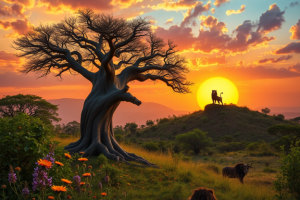The term Renaissance, meaning rebirth, is a French word that designates a period in European history when science, arts and philosophy assumed the upper hand in reenergizing most European societies and the genius of Europe was unbounded from the fetters of centuries-old feudalism and the dawn of a new age announced itself after centuries of darkness. The renaissance period of European history is marked, among other things by new developments in arts and literature.
Another definition maintains that, “The renaissance was a fervent period of European cultural, artistic, political and economic “rebirth” following the middle ages. Generally described as taking place from the 14th to the 17th century, the Renaissance promoted the rediscovery of classical philosophy, literature and art.”
The term renaissance is nowadays used to designate any kind of radical change in contemporary human history. Since the dawn of the 21st century, the term is increasingly being used to characterize a sweeping changes or overhaul, often based on past glories and achievements, not only in arts and literature but also in the political, social and economic lives of nations.
We have thus the term African renaissance which is increasingly used to designate Africa’s renewal through the rediscovery of its past glories and achievements under the new conditions.
African renaissance is a concept that has found currency at the dawn of this century and after Nelson Mandela was released from prison and South Africa became a rainbow nation. Who coined the term ‘African renaissance’? The words first appeared in the tumultuous political and economic revival of the continent when many African countries displayed an unprecedented interest in their continent’s awakening from colonial and post-colonial stagnation, when hope in a better future was reborn and flickers of light appeared in the otherwise dark horizon.
The trouble is that the concept of African renaissance was not as vigorously pursued as it was first articulated. It was relatively more attractive during the last years of the 1990s and the early 2000’s and then it lost momentum as the process was more complex than it was first assumed. Most of all, Africa’s economic rebirth required the close cooperation of the developed West because needs massive capital and technology infusion in order to make its vision a vibrant reality.
Unless there is a paradigm change in relations between Africa and the West, from neocolonial to equal opportunity ones, there is obviously little prospect for success. Africa may depend on itself politically to realize the vision of economic renewal. However, economic renewal is bound to be more problematic for the reason mentioned earlier.
Whether the opportunities or promises are fulfilled now after more than two or three decades is therefore a debatable issue. The idea of African renaissance is not however dead or forgotten. It is sometimes evoked in another slogan that says, “Africa rising”, or Africa fighting for unity and economic freedom which are not yet achieved. So, African renaissance is much more dynamic and assuming global dimensions in the arts and literature. We may perhaps call this ongoing process, Africa’s artistic and cultural renaissance which is more realistic and has even started to deliver as recent documents prove.
The ongoing renaissance in African arts and culture is bound to spill over the economy and even politics as new generations of African arts are likely to use their popularity and the incomes they earn from their works to help address the issues of poverty and underdevelopment in their native Africa. Developments in African arts and culture have thus a spillover effect on other sectors of the African economies besides the cultural industry which in itself is a very lucrative sector.
It is important to note that African art has long started to assume global dimensions particularly since the advent of the new inventions in global information and communication revolution, a process which had barely started a few decades back. African art and culture have immensely benefitted from the ongoing technological advances. In a sense, the revolution in technology has facilitated the birth of African revolution in art and culture.
The revolution in African art is tightly linked to black art in the general and the first black American who is considered the father of the new art is a man from Nashville Tennessee whose name is Aaron Douglas who was, “the most prominent artist-illustrator of the Harlem Renaissance, a movement of the 1920sduring which African Americans developed a unique artistic style.”
Modern African art is often considered revolutionary art not only because it aspires for an African renaissance art but also because, “it is a form of modern art through which artists express their personal convictions about certain issues in society. The pieces of art might also depict political themes. A true revolutionary artist does not care whether the needs of speculative dealers are met or not.”
With the above quotation in mind, modern African writers are out to conquer the world as their achievements testify. Modern African are started to get increased recognition in the early years of the 1980s. “The long -deserved appreciation for African art and artists in the West increased rapidly in the 1989 exhibition, Les Magiciens de la Terre (the magicians of the Earth) at Centre Pompidou in Paris. Africa has witnessed a period of creative flourishing, as more and more international galleries open their door to African exhibitions worldwide.”
The New York Times newspaper in the US recently published an interesting article on 12 African artists that have claimed the global limelight in recent years. The article is justifiably entitled, “Meet the African Artists Driving a Cultural Renaissance around the World”. The subtitle says that “As digital connections bring the African Diaspora together, these 12 creative artists are at the center of the global shift”.
When we talk about African art renaissance these days, we are not talking only about music or literature. Art in its broader sense includes filmmaking, writing of course, and also culinary art or the art of cooking. African art also includes fashion designing, architecture and visual art. According to a recent survey or project, the children of African art renaissance who are currently impacting the global art industry are, among others, “Twelve leading creators from Africa and the Diaspora, as far afield as Asia, Europe and the United States. They include a two-time Oscar winner and a first-time filmmaker, s Michelin star chef and a bestselling author, a fashion designer and an architect, a visual artist and a pop star.”
The survey also mentioned the names of the most popular and young African artists who are emerging as new trend-setters in the art industry. According to the survey, “Today, for the booming young population of Africa and its Diaspora, the relationship is more direct. There is reciprocity of inspiration, fueled by a multitude of creative efforts and propelled by social media platforms like TikTok.” The survey sites plenty of examples like Black panther, a movie inspired and made by upcoming young African filmmakers, like Kindle Wiley, and Omar Victor Diop, Nigeria’s hilarious pulp movies which are binged in homes across Europe and the Caribbean. Add to this the Afro-Pop songs of Kenya’s Sauti Sol and the Afrobeats sounds of Tems, Burma boys and Mr. Fazi.”
Where are young Ethiopian artists in all this? For now they are nowhere to be seen but they are also bound to emerge from anonymity sooner or later. The problem with Ethiopian artists are that they are more introvert or inward looking than extrovert. They are not bold or ambitious enough to storm the global art scene and prefer to stay in the domestic comfort zone.
This is however a recipe for disaster because these days it pays to be extrovert and aggressive in the positive sense because the global art scene is overcrowded with numerous upcoming talents who are jostling for recognition. Ethiopian artists should rather make notable contributions to the African art renaissance that is slowly but surely conquering the continent as well as the world. The African renaissance should not be confined to politics and the economy alone and is expected to include the arts because there is a dynamic relationship and positive interaction between politics, economics and the arts.
BY MULUGETA GUDETA
BY MULUGETA GUDETA
The Ethiopian Herald November 30/2023




